
Arhopala eumolphus, the green oakblue, is a lycaenid butterfly found in the Indomalayan realm. The species was first described by Pieter Cramer in 1780.
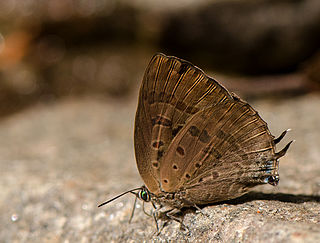
Arhopala alea, the Kanara oakblue or rosy oakblue, is a species of lycaenid or blue butterfly. It is endemic to India. The species was first described by William Chapman Hewitson in 1862.

Arhopala bazaloides, the Tamil oakblue, is a species of lycaenid or blue butterfly found in Asia. The Tamil oakblue is found India in, Myanmar, Sri Lanka and Thailand.

Arhopala silhetensis, the Sylhet oakblue, is a small butterfly found in India that belongs to the lycaenids or blues family. The species was first described by William Chapman Hewitson in 1862.
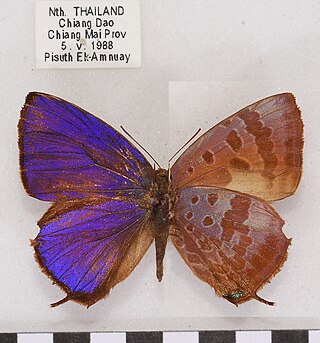
Arhopala agaba, the purple-glazed oakblue, is a small butterfly found from India to Thailand, Langkawi, Indochina, Peninsular Malaysia to the Philippines and Sumatra that belongs to the lycaenids or blues family. The species was first described by William Chapman Hewitson in 1862.

Arhopala aronya is a species of butterfly in the family Lycaenidae first described by William Chapman Hewitson in 1869. Its forewing length is 17–18 mm. It is endemic to the Philippines. It is uncommon or local.

Arhopala aedias, the large metallic oakblue, is a species of butterfly belonging to the lycaenid family described by William Chapman Hewitson in 1862. It is found in Southeast Asia.
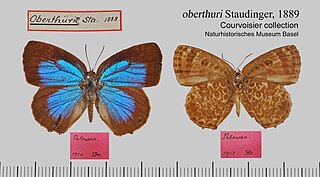
Arhopala alaconia is a species of butterfly belonging to the lycaenid family described by William Chapman Hewitson in 1869. It is found in Southeast Asia.

Arhopala arvina, the purple-brown tailless oakblue, is a species of butterfly belonging to the lycaenid family. It was described by William Chapman Hewitson in 1869. It is found in Southeast Asia.

Arhopala atosia is a species of butterfly belonging to the lycaenid family described by William Chapman Hewitson in 1869. It is found in Southeast Asia - Borneo, Sumatra, Bangka, Pulau Laut, Thailand, Indochina, Peninsular Malaya, Singapore, Burma, Langkawi, Mergui and Palawan.

Arhopala corinda is a species of butterfly belonging to the lycaenid family described by William Chapman Hewitson in 1869. It is found in Southeast Asia.

Arhopala fulla , the spotless oakblue, is a species of butterfly belonging to the lycaenid family described by William Chapman Hewitson in 1862. It is found in Southeast Asia
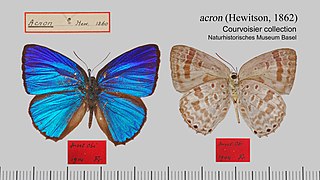
Arhopala acron is a butterfly in the family Lycaenidae. It was described by William Chapman Hewitson in 1862. It is found in the Australasian realm, where it has been recorded from Bachan and Halmahera.

Arhopala admete is a butterfly in the family Lycaenidae. It was described by William Chapman Hewitson in 1863. It is found in the Australasian realm,

Arhopala auxesia is a butterfly in the family Lycaenidae. It was described by William Chapman Hewitson in 1863. It is found in New Guinea and Sumatra. The upper surface of the male is of a bright light bluish-green with a broad dark marginal band, the female dark violettish-blue, with a still broader margin. Beneath distinguished by the spots of the hindwing being also very prominently dark brown.

Arhopala thamyras is a butterfly in the family Lycaenidae. It was described by Carl Linnaeus in 1758. It is found in the Australasian realm.
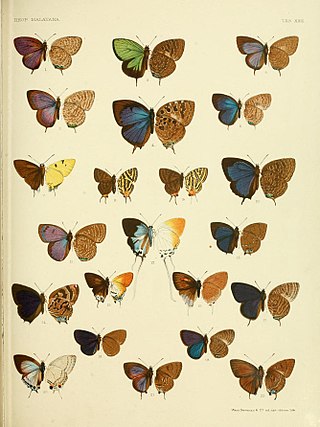
Arhopala metamuta is a butterfly in the family Lycaenidae. It was described by William Chapman Hewitson in 1863. It is found in the Indomalayan realm.

Arhopala aroa is a butterfly in the family Lycaenidae. It was described by William Chapman Hewitson in 1863. It is found in the Indomalayan realm.

Arhopala asopia, the plain tailless oakblue, is a butterfly in the family Lycaenidae. It was described by William Chapman Hewitson in 1869. It is found in the Indomalayan realm.

Arhopala hercules is a butterfly in the family Lycaenidae. It was described by William Chapman Hewitson in 1862. It is found in the Australasian realm. |




















